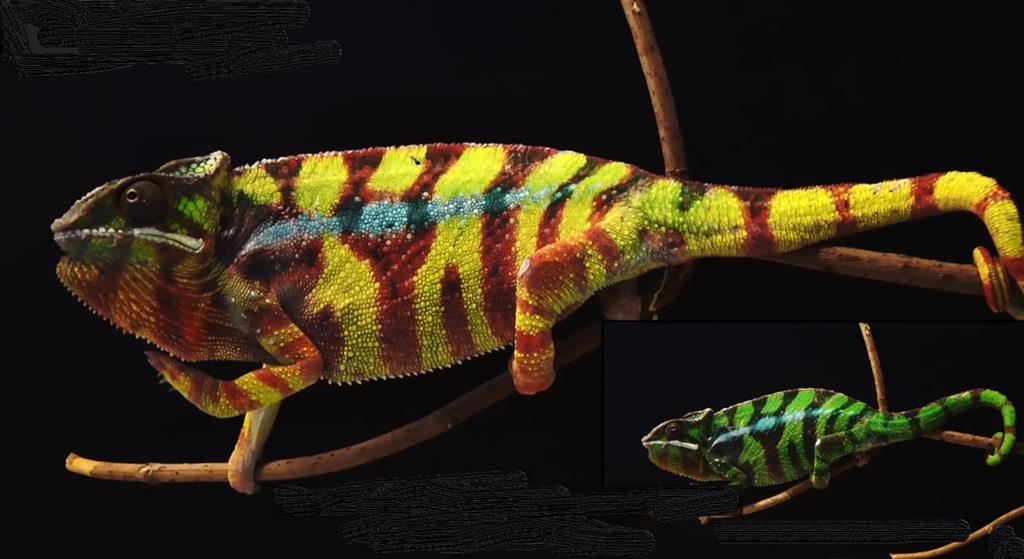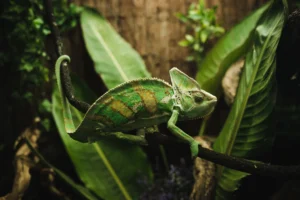During shedding, chameleons often become irritable and may reduce their food intake. They frequently seek rubbing surfaces to aid in removing the old skin.
Chameleons, the masters of camouflage, encounter a natural process in their lives known as shedding or molting, which can alter their behavior. Shedding is crucial for their growth and overall health. These colorful reptiles go through this phase regularly, and it can be a stressful time for them.
Owners might notice their chameleon’s skin turning dull and starting to lift, signaling the start of the shedding process. It is during this period that they might become less active, more prone to hiding, and show signs of discomfort. Chameleons are solitary creatures by nature, and this characteristic becomes more pronounced when they are shedding. Providing them with a stress-free environment and proper husbandry can help ease the shedding process. Understanding these behavioral changes is important for any caretaker to ensure they offer the right care during this time.
The Shedding Cycle In Chameleons
Chameleons are fascinating creatures known for their vibrant color changes and unique appearance. An essential part of their life cycle is shedding, where they cast off their old skin to allow for growth and to remove parasites. Understanding how they act during this time is crucial for proper care.
Signals Indicating The Start Of Shedding
A chameleon announces its shedding phase with distinct behaviors and physical signs. Keep an eye out for these clues:
- Dull, dry skin starts to appear, losing its usual luster.
- They may show reduced appetite as they focus on the upcoming task.
- Restlessness is common as they prepare for the shedding process.
Stages Of The Chameleon Shedding Process
Chameleons work through several stages while they shed:
- Preparation: Skin loosens and their colors may dull.
- Shedding: Skin begins to peel, often starting from the head.
- Post-shed: They may eat shed skin, which is normal and provides nutrients.
During shedding, keep handling to a minimum. Chameleons may become more irritable during this period, so it’s best to give them space. Offering a helping hand by gently misting their enclosure can aid in easing their discomfort and facilitating the shedding process.
Physical And Behavioral Changes
The transformation a chameleon undergoes during shedding is fascinating. Both physical and behavioral changes become evident. Owners may notice distinctive shifts in color and activity, indicating a shedding phase is underway. Recognizing these signs helps in understanding and caring for chameleons effectively.
Color And Texture Transformation
As chameleons prepare to shed, their skin’s color and texture transform noticeably. Typical changes include:
- Duller skin tones: Vibrant colors give way to muted hues.
- Patchy appearance: Skin looks uneven as some areas loosen before others.
- Flaky texture: Old skin peels away, revealing fresh layers beneath.
These changes signify that a chameleon’s body is ready to discard its old skin for growth and health.
Changes In Chameleons’ Movements And Activity Levels
Shedding also impacts a chameleon’s behavior and energy. During this period:
- Decreased appetite: Chameleons might eat less.
- Less movement: They often remain still to reduce stress.
- Rubbing against objects: They assist the shedding process physically.
Observing a chameleon can offer insights into its well-being and how it copes with the shedding process.
Creating The Right Environment For Shedding
When chameleons enter their shedding phase, their behavior may change. They often become more reclusive and display signs of restlessness. As their old skin becomes tight and uncomfortable, they seek the perfect conditions to facilitate a smooth shedding process. Ensuring the right environment is crucial for a healthy shed.
Optimizing Humidity and Temperature
Optimizing Humidity And Temperature
Chameleons thrive in an environment with optimal humidity and temperature. During shedding, these factors become even more vital. The right conditions help their skin loosen and shed evenly. Here’s a short guide to managing these elements:
- Increase humidity: Use a mister or humidifier to boost moisture levels.
- Monitor regularly: Keep a hygrometer handy to check humidity.
- Adjust temperature: Use a thermostat to keep the habitat warm.
The Role of Vegetation and Hiding Spots
The Role Of Vegetation And Hiding Spots
Vegetation and hiding spots offer more than aesthetics in a chameleon’s habitat. During shedding, these features provide security and aid the process. Thick foliage allows chameleons to rub against leaves, promoting skin removal.
- Install plants: Both real and artificial plants work well.
- Create hides: Use branches or special reptile hides for shelter.
- Observe discreetly: Avoid disturbing your chameleon while it sheds.
Do’s And Don’ts For Shedding Support
The shedding process for chameleons can be a delicate time. As a chameleon owner, understanding what to do (and what not to do) provides essential support to your pet. Proper care during shedding ensures a healthy transition to their new layer of skin.
How To Assist Without Causing Harm
To aid your chameleon without causing stress or injury:
- Ensure consistent humidity levels in their habitat.
- Provide additional misting sessions during shedding.
- Place rough surfaces in the enclosure to help shed skin.
- Offer stress-free environments by minimizing handling.
- Monitor the process, but don’t force peel the skin.
Common Mistakes To Avoid During Shedding
Here are key mistakes to steer clear of:
| Don’t Do This | Because |
|---|---|
| Peel the skin manually | It can cause pain and injury |
| Ignore changes in behavior | May indicate discomfort or health issues |
| Let the enclosure dry out | Humidity eases the shedding |
| Disregard hydration | Essential for healthy shedding |
Health Implications Of Shedding Patterns
Chameleons shed their skin periodically as they grow. While shedding is a natural process, it can sometimes reveal important clues about your chameleon’s health. Understanding shedding patterns helps owners detect issues early.
Assessing Shedding For Signs Of Stress Or Illness
During shedding, chameleons might act differently. Healthy shedding should be quick and complete. Watch for changes such as:
- Partial sheds or retained skin
- Increased rubbing against objects
- Reduced appetite or activity
These symptoms may suggest stress or illness. A stable habitat with the right temperature and humidity assists in smooth shedding. Stress can make this process difficult.
When To Consult A Veterinarian
Consult a vet if you notice any concerning signs:
| Signs | Action |
|---|---|
| Retained skin after a shed | It might cause discomfort or infection. |
| Frequent incomplete sheds | Could point to nutritional deficiencies or dehydration. |
| Shedding more often than usual | Reflects potential underlying health issues. |
Immediate veterinary attention may prevent more serious conditions. Regular check-ups enable early problem detection.
Frequently Asked Questions On How Do Chameleons Act When Shedding?
Do Chameleons Act Weird When Shedding?
Chameleons may exhibit unusual behavior such as reduced activity and increased scratching when shedding to facilitate the process. They often appear irritable during this time.
How Do You Know If A Chameleon Is Shedding?
A shedding chameleon will display dull, flaky skin and may show a lack of appetite. This process typically results in the lizard seeking to rub against surfaces to aid in removing old skin.
How Long Do Chameleons Take To Shed?
Chameleons typically take between two days to a week to fully shed their skin, with juveniles shedding more frequently than adults.
How Do I Know If My Chameleon Is Unhappy?
To tell if your chameleon is unhappy, observe its behavior and color. Signs of distress include dull colors, reduced appetite, excessive hiding, and less activity. Regularly check for these indicators to ensure your pet’s well-being.
Conclusion
Chameleons showcase unique behaviors during shedding, indicating their need for care and attention. Caretakers should observe these signs and provide a stress-free environment. Remember, ensuring a healthy diet and humidity aids their natural process. Support your chameleon, and they’ll soon be vibrant and colorful once more.

